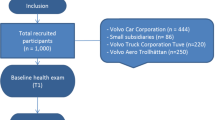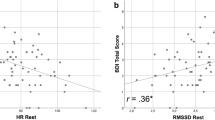Abstract
Interactive effects of anger and anxiety traits, negative affect state, different situations, and gender on cardiovascular reactivity (CVR) to stress were examined. Subjects (91 men, 92 women) performed a reaction time task under either a Social Evaluation, a Harassment, or a Control condition; SBP, DBP, and HR were recorded continuously. Hierarchical multiple regressions revealed intricate interactions. The interaction of anger expression style and anger experience was significant only among men, such that anger suppressors with high trait anger showed the largest CVR of any group during Harassment; anger expressors exhibited generally high CVR across conditions. However, anger expression style and state negative affect interacted to affect CVR in both men and women. Finally, the fear of negative evaluation predicted elevated DBP responses only among men in the Social Evaluation condition. Results imply that the extent to which traits of anger and anxiety contribute to coronary risk may depend on interactions with other traits, gender, and the environment.
Similar content being viewed by others
References
Blascovich, J., and Katkin, E. S. (1993).Cardiovascular Reactivity to Stress and Disease, American Psychological Association, Washington, DC.
Blatt, S. J., Cornell, C. E., and Eshkol, E. (1993). Personality style, differential vulnerability, and clinical course in immunological and cardiovascular disease.Clin. Psychol. Rev. 13: 421–450.
Booth-Kewley, S., and Friedman, H. S. (1987). Psychological predictors of heart disease: A quantitative review.Psychol. Bull. 101: 343–362.
Burns, J. W., and Katkin, E. S. (1992). Commentary: Hostility and the coronary-prone personality. In Friedman, H. S. (ed.),Hostility, Coping, and Health, American Psychological Association, Washington, DC.
Burns, J. W., and Katkin, E. S. (1993). Psychological, situational, and gender predictors of cardiovascular reactivity to stress: A multivariate approach.J. Behav. Med. 16: 445–465.
Burns, J. W., Hutt, J., and Weidner, G. (1993). Effects of demand and decision latitude on cardiovascular reactivity among coronary-prone women and men.Behav. Med. 19: 122–128.
Christensen, A. J., and Smith, T. W. (1993). Cynical hostility and cardiovascular reactivity during self-disclosure.Psychosom. Med. 55: 193–202.
Cohen, J., and Cohen, P. (1975).Applied Multiple Regression/Correlation Analysis for the Behavioral Sciences, Lawrence Erlbaum Associates, Hillsdale, NJ.
Dembroski, T. M., MacDougall, J. M., Williams, R. B., Haney, T. L., and Blumenthal, J. A. (1985). Components of Type A, hostility, and anger-in: Relationship to angiographic findings.Psychosom. Med. 47: 219–233.
Dembroski, T. M., MacDougall, J. M., Costa, P. T., Jr., and Grandits, G. A. (1989). Components of hostility as predictors of sudden death and myocardial infarction in the Multiple Risk Factor Intervention Trial.Psychosom. Med. 51: 514–522.
Diamond, E. L. (1982). The role of anger and hostility in essential hypertension and coronary heart disease.Psychol. Bull. 92: 410–433.
Engebretson, T. O. and Matthews, K. A. (1992). Dimensions of hostility in men, women, and boys: Relationships to personality and cardiovascular responses to stress.Psychosom. Med. 54: 311–323.
Engebretson, T. O., Matthews, K. A., and Scheier, M. F. (1989). Relations between anger expression and cardiovascular reactivity: Reconciling inconsistent findings through a matching hypothesis.J. Personal. Soc. Psychol. 57: 513–521.
Friedman, H. S., and Booth-Kewley, S. (1987). Personality, Type A behavior and coronary heart disease: The role of emotional expression.J. Personal. Soc. Psychol. 53: 783–792.
Friedman, H. S., Hall, J. A., and Harris, M. J. (1985). Type A behavior, nonverbal expressive style, and health.J. Personal. Soc. Psychol. 48: 1299–1315.
Hardy, J. D., and Smith, T. W. (1988). Cynical hostility and vulnerability to disease: Social support, life stress, and physiological response to conflict.Health Psychol. 7: 447–459.
Hecker, M. H. L., Chesney, M. A., Black, G. W., and Frautschi, N. (1988). Coronary prone behaviors in the Western Collaborative Group Study.Psychosom. Med. 50: 153–164.
Helmers, K. F., Krantz, D. S., Howell, R. H., Klein, J., Bairey, N., and Rozanski, A. (1993). Hostility and myocardial ischemia in coronary artery disease patients: Evaluation by gender and ischemic index.Psychosom. Med. 55: 29–36.
Holroyd, K. A., and Gorkin, L. (1983). Young adults at risk for hypertension: Effects of family history and anger management in determining responses to interpersonal conflict.J. Psychosom. Res. 27: 131–138.
Houston, B. K. (1986). Psychological variables and cardiovascular and neuroendocrine reactivity. In Matthews, K. A., Weiss, S. M., Detre, T., Dembroski, T. M., Falkner, B., Manuck, S. B., and Williams, R. (eds.),Handbook of Stress, Reactivity and Cardiovascular Disease, Wiley, New York.
Houston, B. K. (1989). Personality dimensions in reactivity and cardiovascular disease. In Schneiderman, N., Weiss, S. M., and Kaufmann, P. G. (eds.),Handbook of Research Methods in Cardiovascular Behavioral Medicine. Plenum, New York.
Jamner, L. D., Shapiro, D., Goldstein, I. B., and Hug, R. (1991). Ambulatory blood pressure and heart rate in paramedics: Effects of cynical hostility and defensiveness.Psychosom. med. 53: 393–406.
Keppel, G., and Zedeck, S. (1989).Data Analysis for Research Designs: Analysis of Variance and Multiple Regression/Correlation Approaches, W. H. Freeman, New York.
Kneip, R. C., Delamater, A. M., Ismond, T., Milford, C., Salvia, L., and Schwartz, D. (1993). Self- and spouse ratings of anger and hostility as predictors of coronary heart disease.Health Psychol. 12: 301–307.
Krantz, D. S., and Manuck, S. B. (1984). Acute psychophysiologic reactivity and risk of cardiovascular disease: A review and methodologic critique.Psychol. Bull. 96: 435–464.
Lazarus, R. S., and Folkman, S. (1984).Stress, Appraisal, and Coping, Springer, New York.
Linden, W., Chambers, L., Maurice, J., and Lenz, J. W. (1993). Sex differences in social support, self-deception, hostility, and ambulatory cardiovascular activity.Health Psychol. 12: 376–380.
MacDougall, J. M., Dembroski, T. M., and Krantz, D. S. (1981) Effects of challenges on pressor and heart rate responses in Type A and B women.Psychophysiology 18: 1–9.
MacDougall, J. M., Dembroski, T. M., Dimsdale, J. E., and Hacket, T. (1985). Components of Type A, hostility, and anger-in: Further relationships to angiographic findings.Health Psychol. 24: 137–152.
Manuck, S. B., Morrison, R. L., Bellack, A. S., and Polefrone, J. M. (1985). Behavioral factors in hypertension: Cardiovascular responsivity, anger, and social competence. In Chesney, M. A., and Rosenman, R. H. (eds.),Anger and Hostility in Cardiovascular and Behavioral Disorders, Hemisphere, Washington DC.
Matthews, K. A. (1988). Coronary heart disease and Type A behaviors: Update on and alternative to the Booth-Kewley and Friedman (1987) quantitative review.Psychol. Bull. 104: 373–380.
Matthews, K. A., Glass, D. C., Rosenman, R. H., and Bortner, R. W. (1977). Competitive drive, pattern A, and coronary heart disease: A further analysis of some data from the Western Collaborative Group Study.J. Chron. Dis. 30: 489–498.
Matthews, K. A., Davis, M. C., Stoney, C. M., Owens, J. F., and Caggiula, A. R. (1991). Does the gender relevance of the stressor influence sex differences in psychophysiological responses?Health Psychol. 10: 112–120.
Price, V. A. (1988). Research and clinical issues in treating Type A behavior. In Houston, B. K., and Snyder, C. R. (eds.),Type A Behavior Pattern: Research, Theory, and Intervention, Wiley, New York.
Revenson, T. A. (1990). All other things are not equal: An ecological approach to personality and disease. In Friedman, H. S. (ed.),Personality and Disease, Wiley, New York.
Saab, P. G. (1989). Cardiovascular and neuroendocrine responses to challenge in males and females. In Schneiderman, N., Weiss, S. M., and Kaufmann, P. G. (eds.),Handbook of Research Methods in Cardiovascular Behavioral Medicine, Plenum Press, New York.
Siegman, A. W. (1993). Cardiovascular consequences of expressing, experiencing, and repressing anger.J. Behav. Med. 16: 539–569.
Siegman, A. W., and Anderson, R. (1990). Dimensions of hostility and cardiovascular reactivity: The role of provocation. Paper presented at the meeting of the American Psychosomatic Society, Boston, MA, March.
Siegman, A. W., Dembroski, T. M., and Ringel, N. (1987). Components of hostility and the severity of coronary artery disease.Psychosom. Med. 49: 127–135.
Siegman, A. W., Anderson, R., Herbst, J., Boyle, S., and Wilkinson, J. (1992). Dimensions of anger-hostility and cardiovascular reactivity in provoked men.J. Behav. Med. 15: 257–272.
Smith, T. W. (1992). Hostility and health: Current status of a psychosomatic hypothesis.Health Psychol. 11: 139–150.
Smith, T. W., Houston, B. K., and Zurawski, R. M. (1984). Irrational beliefs and the arousal of emotional distress.J. Counsel. Psychol. 31: 190–201.
Spielberger, C. D., Gorsuch, R. L., and Lushene, R. E. (1970).Manual for the State-Trait Anxiety Inventory, Consulting Psychologists Press, Palo Alto, CA.
Spielberger, C. D., Jacobs, G. A., Russell, S., and Crane, R. S. (1983). Assessment of anger: The State-Trait Anger Scale. In Butcher, J. N., and Spielberger, C. D. (eds.),Advances in Personality Assessment, Erlbaum, Hillsdale, NJ.
Spielberger, C. D., Johnson, E. H., Russell, S. F., Crane, R. J., Jacobs, G. A., and Worden, T. J. (1985). The experience and expression of anger: Construction and validation of an anger expression scale. In Chesney, M. A., and Rosenman, R. H. (eds.),Anger and Hostility in Cardiovascular and Behavioral Disorders, Hemisphere, Washington DC.
Stoney, C. M., Davis, M. C., and Matthews, K. A. (1987). Sex differences in physiological responses to stress and in coronary heart disease: A causal link?Psychophysiology 24: 127–131.
Suarez, E. C., and Williams, R. B. (1989). Situational determinants of cardiovascular and emotional reactivity in high and low hostile men.Psychosom. Med. 51: 404–418.
Suarez, E. C., and Williams, R. B. (1990). The relationships between dimensions of hostility and cardiovascular reactivity as a function of task characteristics.Psychosom. Med. 52: 558–570.
Suarez, E. C., Harlan, E. S., Peoples, M. C., and Williams, R. B. (1991). Cardiovascular and emotional responses in women: The role of hostility and harassment.Health Psychol. 53: 459–468.
Tabachnick, B. G., and Fidell, L. S. (1989).Using Multivariate Statistics, Harper & Row, New York.
Turner, S. M., Beidel, D. C., and Larkin, K. T. (1986). Situational determinants of social anxiety in clinic and nonclinic samples: Physiological and cognitive correlates.J. Consult. Clin. Psychol. 54: 523–527.
Watson, S. R., and Friend, R. (1969). Measurement of social-evaluative anxiety.J. Consult. Clin. Psychol. 83: 448–457.
Weidner, G., Friend, R., Ficarrotto, T. J., and Mendell, N. R. (1989). Hostility and cardiovascular reactivity to stress in women and men.Psychosom. Med. 51: 36–45.
Wingard, D. L., Suarez, L., and Barrett-Connor, E. (1983). The sex differential in mortality from all causes and ischemic heart disease.Am. J. Epidemiol. 117: 165–172.
Author information
Authors and Affiliations
Rights and permissions
About this article
Cite this article
Burns, J.W. Interactive effects of traits, states, and gender on cardiovascular reactivity during different situations. J Behav Med 18, 279–303 (1995). https://doi.org/10.1007/BF01857874
Accepted:
Issue Date:
DOI: https://doi.org/10.1007/BF01857874




